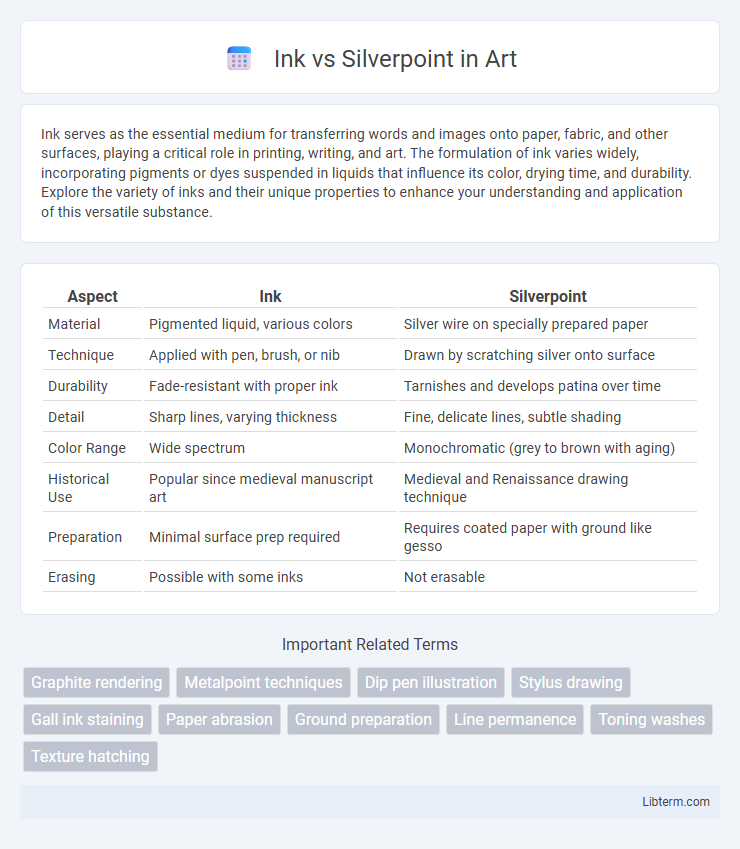Ink serves as the essential medium for transferring words and images onto paper, fabric, and other surfaces, playing a critical role in printing, writing, and art. The formulation of ink varies widely, incorporating pigments or dyes suspended in liquids that influence its color, drying time, and durability. Explore the variety of inks and their unique properties to enhance your understanding and application of this versatile substance.
Table of Comparison
| Aspect | Ink | Silverpoint |
|---|---|---|
| Material | Pigmented liquid, various colors | Silver wire on specially prepared paper |
| Technique | Applied with pen, brush, or nib | Drawn by scratching silver onto surface |
| Durability | Fade-resistant with proper ink | Tarnishes and develops patina over time |
| Detail | Sharp lines, varying thickness | Fine, delicate lines, subtle shading |
| Color Range | Wide spectrum | Monochromatic (grey to brown with aging) |
| Historical Use | Popular since medieval manuscript art | Medieval and Renaissance drawing technique |
| Preparation | Minimal surface prep required | Requires coated paper with ground like gesso |
| Erasing | Possible with some inks | Not erasable |
Introduction to Ink and Silverpoint
Ink, a liquid medium composed of pigments or dyes suspended in a carrier, is widely valued for its versatility in drawing, calligraphy, and printing, offering a range of color intensities and ease of application. Silverpoint, an ancient drawing technique using a slender silver rod to create fine, delicate lines on specially prepared surfaces, is prized for its permanence and subtle tonal variations as the silver tarnishes over time. Both mediums provide unique expressive qualities, with ink allowing bold contrasts and silverpoint delivering intricate, nuanced detail.
Historical Overview of Drawing Mediums
Ink and silverpoint represent two pivotal drawing mediums with distinct historical trajectories and artistic applications. Silverpoint, predominantly used during the Renaissance, relies on a metal stylus to create precise, delicate lines on specially prepared surfaces, prized for its permanence and fine detail in early portraiture and studies. Ink, emerging prominently in medieval manuscripts and flourishing through the Renaissance to modern times, offers versatility in tone and stroke, enabling a broader range of expression and durability in illustrations and calligraphy.
Material Composition: Ink vs Silverpoint
Ink, primarily composed of pigments or dyes suspended in a liquid base such as water or oil, offers a wide range of colors and ease of application on various surfaces. Silverpoint consists of a thin silver wire stylus used to draw on specially prepared surfaces, where the metal gradually oxidizes to create delicate, fine lines. Unlike ink, silverpoint markings do not require drying but lack the immediate boldness and versatility of colored pigments.
Techniques and Application Methods
Ink techniques involve using liquid pigments applied with brushes, pens, or quills to create bold lines, varying textures, and washes, allowing for versatile expression in illustration and calligraphy. Silverpoint relies on a metal stylus that deposits fine silver particles on coated paper or prepared surfaces, producing delicate, precise lines with subtle tonal variations, commonly used in detailed drawings and early Renaissance art. The application of ink permits rapid shading and layering, while silverpoint demands careful, controlled strokes without the possibility of erasure, emphasizing permanence and refinement.
Line Quality and Visual Effects
Ink produces bold, consistent lines with high contrast, ideal for precise detailing and graphic clarity, while silverpoint offers delicate, subtle lines that darken over time due to oxidation, creating a soft, antique aesthetic. The permanence of ink lines resists smudging and fading, whereas silverpoint's fragile marks require careful preservation but reward with a unique, shimmering texture. Ink suits modern, vibrant compositions, whereas silverpoint emphasizes fine, intricate textures with a timeless, elegant visual appeal.
Durability and Longevity
Ink offers superior durability compared to silverpoint, as it resists fading, smudging, and environmental damage over time. Silverpoint, made using a fine silver wire on a specially prepared surface, is highly stable but can tarnish and requires careful preservation to maintain its longevity. Both mediums demand proper storage conditions, though ink artworks generally withstand aging and handling better than silverpoint drawings.
Artistic Styles and Notable Works
Ink offers versatility in artistic styles, enabling bold line work, intricate details, and dynamic shading, as seen in Albrecht Durer's precise engravings and Leonardo da Vinci's detailed sketches. Silverpoint, favored during the Renaissance, produces delicate, fine lines with subtle tonal variations, exemplified by Raphael's studies and early works by Jan van Eyck. Notable pieces in silverpoint reflect a permanent, refined aesthetic, while ink artworks often display a broader range of expression and contrast.
Modern Uses and Revivals
Silverpoint has experienced a resurgence among contemporary artists valuing its fine lines and archival permanence, often used for detailed drawings and mixed media art. Ink remains dominant due to its versatility, vibrant color range, and adaptability to modern tools like markers and digital pens. Both mediums are explored in modern art education to blend traditional craftsmanship with innovative techniques.
Pros and Cons: Choosing the Right Medium
Ink offers bold, versatile lines and quick drying time, ideal for detailed illustrations and dynamic artworks, but it can smudge and lacks the subtlety of tonal variation. Silverpoint provides delicate, precise marks with a unique metallic sheen that ages beautifully over time, though it requires a specially prepared surface and is less forgiving for corrections. Selecting the right medium depends on the desired texture, longevity, and ease of use for the artist's specific project.
Conclusion: Which Medium Suits Your Art?
Ink offers versatility and boldness, ideal for artists seeking strong contrasts, fluid lines, and diverse techniques such as washes and cross-hatching. Silverpoint delivers delicate, precise marks with a unique, ethereal quality that suits detailed, subtle works and classical drawing styles. Choosing between ink and silverpoint depends on the desired visual effect, permanence, and the artist's technical preference for either dynamic fluidity or refined, meticulous detail.
Ink Infographic

 libterm.com
libterm.com